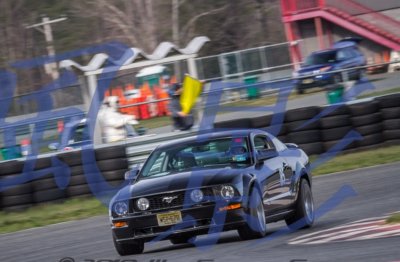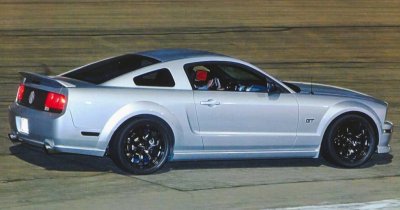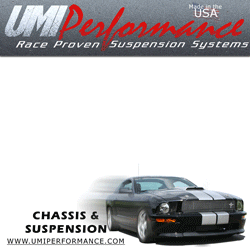Pentalab - you'd also need to know how much the roadway itself is cambered (yes, camber is term that is applied to the road surface in highway design as well as to wheel alignment). IOW, if the road or track is cambered by 2° down to the inside, your car is cornering at 1.00g, and rolls at 2° per g, the chassis will be sitting perfectly level as a bubble level sees it. If you look at the last photo on page 1 of JJ's photo link, you can see how this works.
Here's my car in a corner at 1g or a bit more per datalog. Not nearly as much roll as JJ is suggesting. Feel free to find any distortion along the chassis that a pair of 1 x 2 jacking rails could even start to reduce. Take as much time as you want; I doubt you'll find any.
View attachment 69593
Norm
If the road or track is cambered by say 2 degs to the inside, that can be factored into the equation. Either drive through it real slow, or stop every few feet, take measurements, then either factor it in.... or simply use the 'zero out' feature. Ok, say it is a consistent 2 degs..and we then zero the reading out. Take the corner at speed, and at 1G, it should read aprx + 2.0 degs. Or don't zero it out, then it should indicate...0.0 degs. Moot point really.
Norm, your calcs / software/ analysis may be on track / correct, but it still does not explain the effect that both myself and jj427r are seeing. This is not some subtle difference either, blatantly obvious that something somewhere has changed.
"I suspect that any increase in stiffness (esp torsional) may well enhance the effect of the front sway bar."
"I think you're almost on the right track. But the front sta-bar stiffness is what it is and is not increased by adding jacking rails. What the jacking rails may or may not do is increase the amount of moment being resisted at the front vs at the rear.
Keep in mind that chassis stiffness affects roll moment distribution to the rear as well as to the front. Turns out in this case a little less roll moment is attracted to the front - which actually makes the front roll a little less with the rails than without them. It's the rear that's more affected, a little more moment and a little more roll."
.................................................................................................................................................
Norm, your comments above is what I was alluding to. With the jacking rails installed, and say taking a sharp left hander, the front sway bar now has the entire left side of the car to contend with....and not just the left front portion.
In my case, the front ends of each steeda jacking rail has a flat plate welded to it, with the flat plate facing inboard....(90 degs to the 2" x 1" CM jacking rails) These flat plates terminate on the same pair of oem bolts that secure the oem cross brace, located behind the eng. Back end of each steeda jacking rail, also has a flat plate welded to it, but this time, in line with the jacking rail. Each aft end plate is then sandwiched between the 'steeda tq box brace'...and inboard side of pinch weld. There is 2 x oem threaded holes to bolt the 2 x steeda items together. These pair of threaded holes on each side were for the rear oem convertible support braces, used on all verts.
The steeda tq box braces are a cm triangular affair, with corner #1 terminated on the front end of each lca mount ( 2 x bolts + welded). Corner #2 is well inboard, welded onto inboard longitudinal member.
Corner #3 has a piece of channel steel welded to it..and terminates ( 2 x bolts + welded) to the aft end of the steeda jacking rail plates. I also have the oem cross brace that ties the back end of the K frame together, plus a BMR A arm brace, that ties the front A arms together. Roush 37mm front sway bar...and a pair of steeda front sway bar braces..... + a steeda front STB over eng..and steeda eng mounts..with their stiff durometer mounts.
Steeda rear stb (welded) in trunk. Roush rear 27mm sway bar. BMR rear tunnel brace, located between the inboard pair of #2 corners of the steeda tq box braces...(forms one continuous brace from extreme right side of car to extreme left side) . Roush lowering springs front + rear, and roush monotube shocks. ( + DSS-DS / whiteline watts link / Eaton tru-trac).
Point here is, in my case, with the recent addition of the pair of steeda jacking rails, it's now one continuous brace...from eng cross brace... straight back to the front end... of each rear LCA mount.
The addition of the CM jacking rails appears to be the final missing piece of the puzzle.... now tying the rigid front end....to the rigid back end of the car. The entire affair is pretty damned rigid. You folks can call it placebo effect, confirmation bias, pseudo junk science, or anything else you care to. I call it..."something has changed overnight...and it's more than a subtle difference". Local ford dealer only has two drive on lifts, and both were tied up....so my car stayed inside their shop overnight. I pick it up the next day, after lunch, drive 6 miles home, and wonder what the F#@K just happened to my car.




